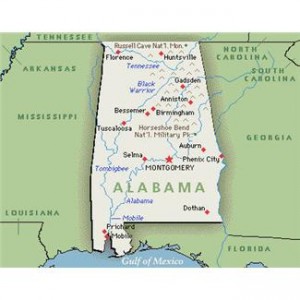Contract exclusion bars municipal insurer’s claim for coverage under E&O policy for settlement payment to its own insured
by Christopher Graham and Joseph Kelly
Scottsdale Insurance Company v. Alabama Municipal Insurance Corporation, Case No. 2:11-cv-668-MEF (M.D. Ala. Sept. 16, 2013)3
Scottsdale issued a professional liability policy to Alabama Municipal Insurance Corporation (“AMIC”). AMIC is a non-profit mutual insurance company that issues insurance policies to Alabama governmental entities.
AMIC issued an insurance policy to the Town of Woodland, Alabama that covered, in pertinent part, property damage caused by an accident resulting from the use of a covered automobile with a $2 million occurrence limit. On November 24, 2009, a covered automobile was involved in a single-vehicle accident in Georgia resulting in injuries to two passengers and ultimately one passenger’s death. The passengers sued the driver and and the Town of Woodland in Georgia; AMIC defended; and the passengers won a $4 million judgment. Subsequently, the Georgia court issued a declaration that AMIC’s $2 million limit applied rather than the $100,000 per occurrence limit under Alabama’s law that limits municipal liability. AMIC had argued it only would be liable for $200,000 under that Alabama law — $100,000 for the driver and $100,000 for the Town.
AMIC, the driver, and the Town subsequently: (1) filed suit in Alabama seeking a declaration that the Alabama limit on municipal liability applied to the Georgia judgment; and (2) appealed the Georgia declaratory judgment. Argument on the Georgia appeal was set for July 14, 2011.
Meanwhile, on January 24, 2011, the passengers sued AMIC for bad faith failure to settle within policy limit, asserting standing to sue under AMIC’s insurance policy. The passengers sought $1.99 million for AMIC’s rejection of its earlier settlement demand (passengers had offered to settle for $2 million). The passengers went on to win the $4 million judgment after AMIC rejected its demand. The passengers in their bad faith case sought the excess $2 million of the $4 million verdict from AMIC.
AMIC tendered the bad faith suit to Scottsdale. NAMICO was Scottsdale’s administrator for AMIC’s claim. NAMICO defended under a February 2, 2011 general reservation of rights. NAMICO subsequently issued a specific reservation of rights letter that listed the contractual obligation exclusion, among other exclusions, as a potential reason to deny coverage. NAMICO and defense counsel expressed doubt that the Alabama law would be found to apply.
The passengers offered to settle the bad faith case for $2 million. AMIC still felt strongly that the Alabama law would apply so it didn’t want to settle. NAMICO in turn raised the “hammer clause” from Scottsdale’s policy under which Scottsdale can stop defending a claim if its insured refuses to accept a settlement recommended by Scottsdale. NAMICO warned AMIC that if it didn’t agree to settle, NAMICO would stop defending and that AMIC would be responsible for its own defense.
AMIC then offered to pay $200,000 towards settlement (the amount it at least owed if the Alabama law applied) and split the remaining $1.8 million settlement payment with Scottsdale. Scottsdale agreed but reserved its right to recover its $900,000 payment. The passengers bad faith subsequently settled for $2 million and Scottsdale sought a declaratory judgment that it wasn’t obligated to pay its share of the settlement because of the Scottsdale policy’s “contractual obligation” exclusion.
THE SCOTTSDALE POLICY
Scottsdale’s policy covered “all LOSS resulting from a CLAIM alleging an act, error or omission in the performance of PROFESSIONAL SERVICES…”; and among the “PROFESSIONAL SERVICES” covered by the policy are “claim handling and adjusting.”
Scottsdale’s policy excludes coverage for:
I. Any CLAIM arising from, based upon, attributable to, or related in any way (directly or indirectly) to any contract obligation, whether real or alleged, assumed by or imposed upon an INSURED arising out of:
- any policy or contract of insurance, reinsurance, insurance pool, suretyship, annuity or endowment; or
- any written contract, unless the INSURED would have been liable in the absence of such contract.
Scottsdale’s policy also contained the hammer clause mentioned above.
DISCUSSION
As a threshold matter, the court rejected AMIC’s argument that the initial general reservation of rights was too general to deny coverage and that the subsequent specific reservation of rights was untimely. The court noted that under Alabama law, “a general reservation of rights is sufficient to allow an insurer to later deny coverage under a specific policy exclusion” and, thus, the general reservation of rights was sufficient to reserve Scottsdale’s right to deny coverage.
AMIC argued that the contract exclusion doesn’t apply to exclude coverage because it renders Scottsdale’s coverage illusory. AMIC argues that since it conducts all its business through insurance contracts, if liability incurred under insurance contracts is excluded, then there’s no coverage under the policy.
The court rejected AMIC’s argument that the exclusion makes Scottsdale’s coverage illusory, noting that the policy provides coverage for errors and omissions arising from claims handling and the exclusion “simply distinguishes between liability incurred by AMIC for breach of contract with its insureds, and liability incurred for negligent acts and omissions committed by AMIC in handling claims arising from its insurance contracts.” The court further stated “the policy does not require Scottsdale to take the place of AMIC with respect to AMIC’s insurance contracts.”
AMIC argued further that the contract exclusion doesn’t apply to exclude coverage because it was sued for bad faith — a tort — rather than for breach of contract. The court rejected this argument as well, noting that the relevant inquiry is whether AMIC’s loss arose out of its contractual obligations to its insured; the bad faith suit arose out of AMIC’s refusal to meet its contractual obligations to its insureds.
Tags: Alabama, E&O, insurance, contract exclusion
Category: D&O Digest Comment »

